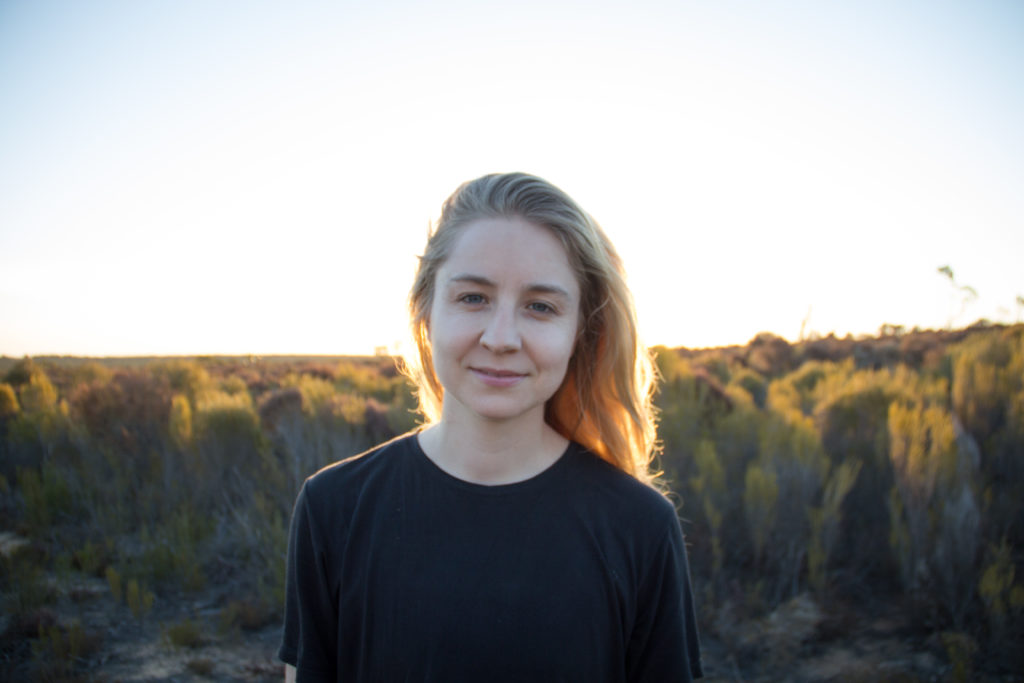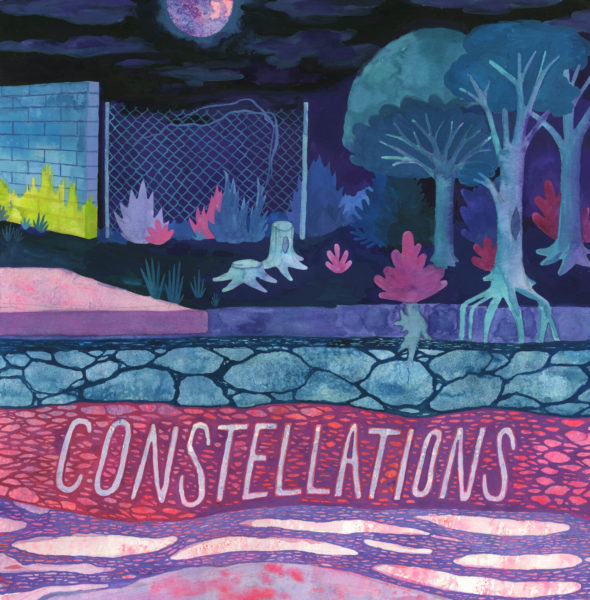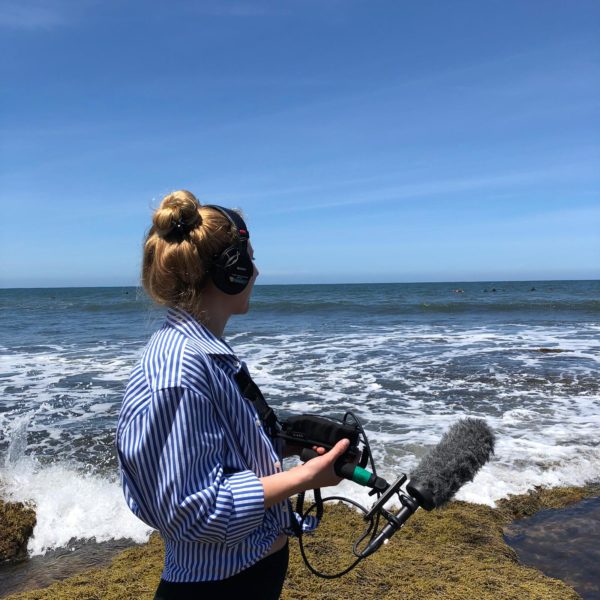Michelle Macklem is a producer, artist and artistic director of Constellations.
In this edition of Working with Sound, Michelle contemplates her style, rhythm and approach; the importance of play and joy; and her bratty mixer alter-ego.

What piece of audio has had the most profound effect on you – as a listener, as an audio maker or both?
When I was starting out, I spent a lot of time trolling through Third Coast’s website, discovering different audio makers and artists. I’d come across Sarah Boothroyd through an episode of Re:sound I think, and was struck by her piece Forest to Desert. It’s such a short audio work – coming in at just over 2 and a half minutes – but the use of sound is so powerful and engaging. It’s an excellent example of how powerful and effective sound is as a medium, especially where voice isn’t centered. In that 2 and a half minutes, we experience the effects of over a century of extraction, environmental degradation and unfettered economic growth, without having a single voice narrate it. It’s a piece that I go back to a lot – I probably listen a few times a year – and often use as an example when I teach working with sound.
Where else do you find influence or inspiration for your work?
A lot of my inspiration these days comes from listening to music or being outside. Recently, I’ve loved being outside walking next to a nearby creek during that hour that stretches from just before sundown to after. The soundscape changes so dramatically. Squawking parrots quiet down and bats start to beat overhead. The creaky scales of frogs shift to the warm hum of crickets. Dusk is so beautiful in Australia.
Where do you work? And what tools help you the most?
I work best outside of my home, so I’m really fortunate to have access to a studio space. I’ve realised that what helps me most is to have constraints on the tools I use, often I can get so lost in looking up new plugins, gear or sounds to work with, and its important to limit myself a bit and just give myself a gentle reminder to stay with what I have in front of me. Oh and a glass of water. Always having water around while I work is so important!
So these days, it’s just a laptop, a small sony recorder and a keyboard. I’m working with a lot of samples, not in a particularly profound or interesting way, but I’m interested in how sounds can shift and change, how to stretch, pitch and modulate sounds in really tactile ways. That’s pretty easy to do with most DAWs but I’m having a lot of fun in Ableton these days. Finding time to mess around with these samples without a particular plan or target has helped me restart finding some of joy and passion with sound that’s dampened in the past months.

Where did the idea for this season of Constellations come from?
This season of Constellations has been a significant change in how we work and space we’ve given ourselves to think. Jess Shane (the co-founder of Constellations) and I created a programming committee to expand out what Constellations could be and bring some new minds into the project. We’d operated on this kind of month-to-month way previously which could be stressful, so we wanted to plan out the season ahead and give ourselves more time with the artists and their works. Aliya Pabani, Dennis Funk (who had to leave the committee midway through the year due to other commitments), Matthew Kariatsumari and Miyuki Jokiranta all joined the programming committee this year and we decided to do a call for pitches, and ended up receiving over 100 submissions, which was quite overwhelming. I mean, it was exciting and a real honor that people trusted us with their ideas, and I also felt a huge sense of responsibility to go through each of the pitches and the artists’ work to get to know them and their sensibilities.
We didn’t step into this season with a particular theme or idea, more just an intention to look for pieces and artists who were engaged with listening practices and critical pathways into thinking about sound and narrative. As submissions rolled in, we found there were ways of grouping certain pieces together around a theme or question, so that worked out well.
What is your favourite part of making Constellations?
Finding the joy and humour in working with sound. I have a joke with a few of my friends that I have a bratty mixing alter-ego and she’s responsible for the silly editing this season. In a time where everything has been serious and hard and exhausting, it’s been helpful to have this outlet where I can release myself from that space for even a few minutes to make something a bit wacky and weird that may not even make it into an episode, but can just allow me to let loose a little. That’s something I realised I’d really lost in the past couple of years, making space in my life to play, not have outcomes and just be in awe of sound.
 What was the biggest challenge working on Constellations?
What was the biggest challenge working on Constellations?
I’d mentioned before that we received over 100 submissions for Constellations this year, so that was quite intense! But I also think the nature of the project and how we release episodes has also been a challenge. We’ve released on roughly a fortnightly schedule, perhaps as a kind of hangover from working in the podcast industry, and I’m excited to change that up going forward.
What’s the best (or worst) advice you’ve received about working in radio and podcasting?
One of the best pieces of advice I’ve been given was by fellow artist and audio producer Veronica Simmonds which is: when in doubt, always go back to the tape. When I’m stuck, I have a tendency to look outside the project or work to come up with some kind of solution, and I’ve realized just stopping and reminding myself to return to the original material is key. Even just spending 20 minutes sitting with the raw tape and listening can help me remember how I got here, and what I’m curious about.
As an audio maker, what have been your biggest lessons so far?
Finding my voice, again and again. Especially as an artist and maker where my literal voice doesn’t often feature in my work, how can I find my own style, rhythm and approaches and give myself space to do the work. Having space away from the perspectives of other makers, like having space away from social media, can be helpful to help mitigate comparing my voice, or my work, to others.
Do you think the work you make reflects your personality? If so – in which ways?
This is something I feel like I’ve worked at a bit. When I started out, I made work that was fairly self-serious, I think there’s something about being a young artist and wanting people to take you seriously. But as I’ve gone on, I’m more curious about making things with a sense of play. Finding silly, joyous moments in sound and letting those fill my ears has been such a treat.
When in doubt, always go back to the tape.
If you could go out to dinner with any audio maker, who would it be – and what would you talk about?
I’d love to go out to dinner with Sherre DeLys. I’m such a fan of Sherre’s work and her approach to sound, listening and performance. But I’d also be so thrilled to have dinner with the Constellations programming committee. Since Miyuki and I are in Australia and the rest of the committee is in Canada, we’ve never actually gotten to all meet up in person. So that’d be a real dream, having dinner with Aliya, Matthew, Jess and Miyuki. I’d love to catch up about what we’ve all been most curious about this year — what’s stayed with us through the challenges, separations and disjointed chaos of the past months. What do we all genuinely want to spend our energies and time focussing on? And how can using sound as a medium create a different approach or way into thinking about these curiosities?
What are you listening to at the moment?
I’ve just started catching up on podcasts from the year really. I’ve just finished Sharon Mashihi’s podcast Appearances, which was great. It felt like a one-woman theatre performance that embraces pitch shifting voices and creating bold and alive characters in an absorbing way. BirdNote’s series Grouse reported by Ashley Ahearn has been a fascinating way into thinking about the environment and the interconnectedness of a single species with the wider ecology of the land. Back in September, Aliya Pabani worked on a podcast called We Are Not the Virus, which is a necessary and personal vantage point into the lives of folks living in an encampment in Toronto during the pandemic. I’ve also enjoyed sinking into the latest Soundhouse exhibition: Intimacy and Distance. I’ve loved getting to hear audio selections from the artists Ariana Martinez, Axel Kacoutié and Arlie Adlington. It’s lovely to have curated playlists with meaning, intention and force behind them.
 What’s your favourite Australian podcast, and why?
What’s your favourite Australian podcast, and why?
I was totally engrossed with the ABC RN series Oz Gothic that’s produced by Camilla Hannan. I’m not always drawn to fiction, but there was something about this series – each episode a short story and snapshot of a different tense, alert moment – that got my attention. Not being from Australia, it was also a great introduction to incredible writers, like Tony Birch and Julie Koh whose work I hadn’t been familiar with before, and getting to hear them brought to life through sound. There’s an eeriness to the series, like something unsettling you can’t entirely put your finger on, but you still want to press play. The Pool, for example, follows the story of this microaggression, almost a blip of an event, and how it plays out in this uncomfortable suburban context. The original sound design is rich, expansive and brings that landscape to life in a way that makes the series stand out.
What – if anything – do you think distinguishes Australian audio? What would you like to hear more of?
My favourite Australian audio has always been connected to sounds of the land and landscape. From little gems of pieces like Paper Radio’s The Big Prawn to documentary work like Kaye Mortley’s time at the ABC, to what I’d just mentioned with Oz Gothic, there’s something about engaging with this landscape through sound that feels unique: the sounds of coastlines, deserts, forests, all swarming with life. If anything, going forward I’d love to hear more of this, how to engage with stories that place the landscape and the people connected to it at the centre of the story.
What’s next?
Learning how to listen better and engage more deeply with sound. It’s a lifelong practice for sure. This year has been a lot about being in survival mode, so now that we’ve wrapped this season of Constellations, I’m looking forward to having time to rest and reflect before moving forward with the project. But yeah, listening, always listening.
Constellations is available to listen to here.